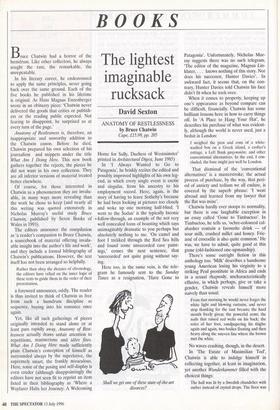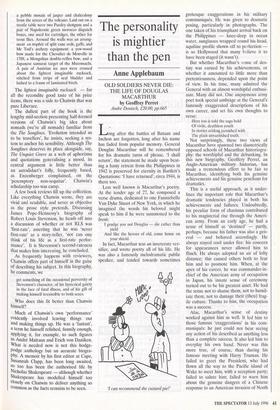BOOKS
The lightest imaginable rucksack
David Sexton
ANATOMY OF RESTLESSNESS by Bruce Chatwin Cape, £15.99, pp. 205
Bruce Chatwin had a horror of the humdrum. Like other collectors, he always sought the rare, the remarkable, the unrepeatable.
In his literary career, he endeavoured to apply the same principles, never going back over the same ground. Each of the five books he published in his lifetime is original. As Hans Magnus Enzenberger wrote in an obituary piece: `Chatwin never delivered the goods that critics or publish- ers or the reading public expected. Not fearing to disappoint, he surprised us at every turn of the page.'
Anatomy of Restlessness is, therefore, an inappropriate and unworthy addition to the Chatwin canon. Before he died, Chatwin prepared his own selection of his journalism and snippets under the title What Am I Doing Here. This new book gathers together the rejects, the pieces he did not want in his own collection. They are all inferior versions of material treated better elsewhere.
Of course, for those interested in Chatwin as a phenomenon they are invalu- able, in many ways more revealing than the work he chose to keep (and nearly all this writing was quoted extensively in Nicholas Murray's useful study Bruce Chatwin, published by Seren Books of Wales in 1993).
The editors announce the compilation as 'a reader's companion to Bruce Chatwin, a sourcebook of material offering invalu- able insight into the author's life and work', and they include a formal bibliography of Chatwin's publications. However, the text itself has not been arranged so helpfully.
Rather than obey the dictates of chronology, the editors have relied on the inner logic of these texts to guide them in the order of their presentation,
a foreword announces, oddly. The reader is thus invited to think of Chatwin as free from such a humdrum discipline as sequence, buying into his romance once again.
Yet, like all such gatherings of pieces originally intended to stand alone or at least pass rapidly away, Anatomy of Rest- lessness actually draws unfair attention to repetitions, mannerisms and idees fixes. What Am I Doing Here made sufficiently plain Chatwin's conception of himself as surrounded always by the superlative, the supremely smart, the frankly miraculous. Here, some of the posing and self-display is even cruder (although disappointingly the editors have not seen fit to reprint an item listed in their bibliography as 'Where a Wayfarer Halts her Journey: A Welcoming
Home for Sally, Duchess of Westminster' printed in Architectural Digest, June 1985) In 'I Always Wanted to Go to Patagonia', he briskly recites the edited and possibly improved highlights of his own leg- end, in which every single event is exotic and singular, from his ancestry to his employment record. Here, again, is the story of having to leave Sotheby's because he had been looking at pictures too closely and woke up one morning half-blind. 'I went to the Sudan' is the typically laconic • follow-through, an example of the not very well concealed form of boasting which says unimaginably dramatic to you perhaps but absolutely nothing to me. 'On camel and foot I trekked through the Red Sea hills and found some unrecorded cave paint- ings,' comes the next sentence, that 'unrecorded' not quite going without say- ing.
Here too, in the same vein, is the tele- gram he famously sent to the Sunday Times as a resignation, 'Have Gone to Shall we get one of these state-of-the-art divorces?
Patagonia'. Unfortunately, Nicholas Mur- ray suggests there was no such telegram. 'The editor of the magazine, Magnus Lin- klater, ... knows nothing of this story. Nor does his successor, Hunter Davies'. In awkward fact, it seems that, on the con- trary, Hunter Davies told Chatwin his face didn't fit when he took over.
When it comes to property, keeping up
I weighed the pros and cons of a white- washed box on a Greek island, a crofter's cottage, a Left Bank garconniere, and other conventional alternatives. In the end, I con- cluded, the base might just well be London.
That dismissal of the 'conventional alternatives' is a masterstroke; the actual process of purchase, by the way, that peri- od of anxiety and tedium we all endure, is covered by the superb phrase: 'I went abroad and learned from my lawyer that the flat was mine'.
Chatwin hardly ever stoops to normality, but there is one laughable exception in an essay called 'Gone to Timbuctoo'. In Timbuctoo, he tells us, 'ochre-coloured cal- abashes contain a favourite drink — of sour milk, crushed millet and honey. Fric- assd of crocodile is also quite common.' He was, we have to admit, quite good at this game (old-fashioned one-upmanship). There's some outright fiction in this anthology too. 'Milk' describes a handsome young American losing his virginity to a striking Peul prostitute in Africa and ends in a sexual rhapsody, uncharacteristically effusive, in which perhaps, give or take a gender, Chatwin reveals himself more naively than usual:
From that morning he would never forget the white light and blowing curtains, and never stop thanking for the taut breasts; the hard mouth freely given; the powerful arms; the nails that raised red welts on his back; the soles of her foot, sandpapering his thighs; again and again, two bodies floating and then heavy along the uneven line where the brown met the white.
No waves crashing, though, in the desert. In 'The Estate of Maximilian Tod', Chatwin is able to indulge himself in collecting together, at least in imagination, yet another Wunderkammer filled with the choicest things:
The hall was lit by a Swedish chandelier with amber instead of crystal drops. The floor was
a pebble mosaic of jasper and chalcedony from the screes of the volcano. Laid out on a trestle table were two Purdey shotguns and a pair of Napoleonic green morocco dispatch boxes, one used for cartridges, the other for trout flies. Around the walls was an arrang- ment en trophee of split cane rods, gaffs, and Mr Tod's archery equipment: a yew-wood bow made for the Chevalier de Monville in 1788, a Mongolian double-reflex bow, and a Japanese samurai target of the Muromachi. A pair of Austrian ice axes were crossed about the lightest imaginable rucksack, stitched from strips of seal bladder and lashed to a frame of laminated birch.
The lightest imaginable rucksack — for all the recondite good taste of his prize items, there was a side to Chatwin that was pure Liberace.
The dullest part of the book is the lengthy mid-section presenting half-formed versions of Chatwin's big idea about nomads (we're all nomads) familiar from the The Songlines. 'Evolution intended us to be travellers', he insists, seeking a sys- tem to anchor his sensibility. Although The Songlines deserves its place alongside, say, The Unquiet Grave as a web of aphorisms and quotations generalising a mood, its central argument is little better than an autodidact's folly, frequently based, as Enzenberger complained, on the 'peremptory non-sequitur'. Chatwin's scholarship too was camp.
A few book reviews fill up the collection. Like everything Chatwin wrote, they are vivid and readable, and never as objective as the prose style pretends. Discussing James Pope-Hennessy's biography of Robert Louis Stevenson, he heads off into a discussion of whether or not RLS was 'first-rate', asserting that he was 'never first-rate' as a story-teller, 'nor can one think of his life as a first-rate perfor- mance'. It is Stevenson's second-rateness that makes him interesting, he concluded. As frequently happens with reviewers, Chatwin offers part of himself in the guise of describing his subject. In this biography, he comments, we get something of the occasional perversity of Stevenson's character, of his hysterical gaiety in the face of fatal illness, and of his gift of making himself irresistible to both sexes.
Who does this fit better than Chatwin himself?
Much of Chatwin's own 'performance' evidently involved leaving things out and making things up. He was a 'fantasy, a term he himself relished, funnily enough, applying it, for example, to such figures as Andre Malraux and Erich von Daniken. What is needed now is not this hodge- podge anthology but an accurate biogra- phy. A memoir by his first editor at Cape, Susannah Clapp, has been long awaited, so too has been the authorised life by Nicholas Shakespeare — although whether Shakespeare has modelled himself too closely on Chatwin to deliver anything so Common as the facts remains to be seen.



































































 Previous page
Previous page